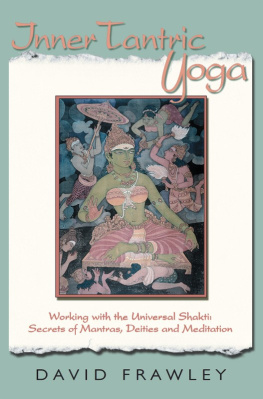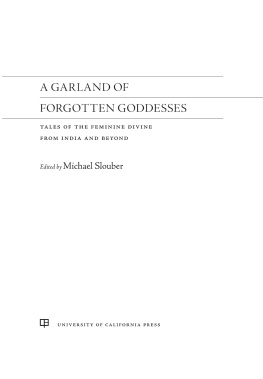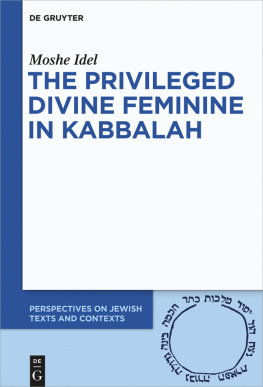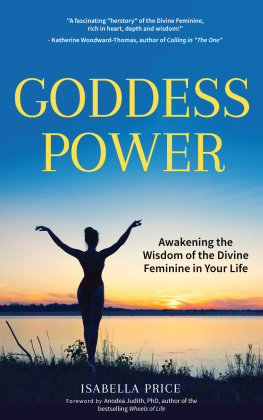David Kinsley - Tantric Visions of the Divine Feminine
Here you can read online David Kinsley - Tantric Visions of the Divine Feminine full text of the book (entire story) in english for free. Download pdf and epub, get meaning, cover and reviews about this ebook. publisher: University of California Press, genre: Romance novel. Description of the work, (preface) as well as reviews are available. Best literature library LitArk.com created for fans of good reading and offers a wide selection of genres:
Romance novel
Science fiction
Adventure
Detective
Science
History
Home and family
Prose
Art
Politics
Computer
Non-fiction
Religion
Business
Children
Humor
Choose a favorite category and find really read worthwhile books. Enjoy immersion in the world of imagination, feel the emotions of the characters or learn something new for yourself, make an fascinating discovery.

- Book:Tantric Visions of the Divine Feminine
- Author:
- Publisher:University of California Press
- Genre:
- Rating:3 / 5
- Favourites:Add to favourites
- Your mark:
- 60
- 1
- 2
- 3
- 4
- 5
Tantric Visions of the Divine Feminine: summary, description and annotation
We offer to read an annotation, description, summary or preface (depends on what the author of the book "Tantric Visions of the Divine Feminine" wrote himself). If you haven't found the necessary information about the book — write in the comments, we will try to find it.
Tantric Visions of the Divine Feminine — read online for free the complete book (whole text) full work
Below is the text of the book, divided by pages. System saving the place of the last page read, allows you to conveniently read the book "Tantric Visions of the Divine Feminine" online for free, without having to search again every time where you left off. Put a bookmark, and you can go to the page where you finished reading at any time.
Font size:
Interval:
Bookmark:
Tantric Visions of the Divine Feminine
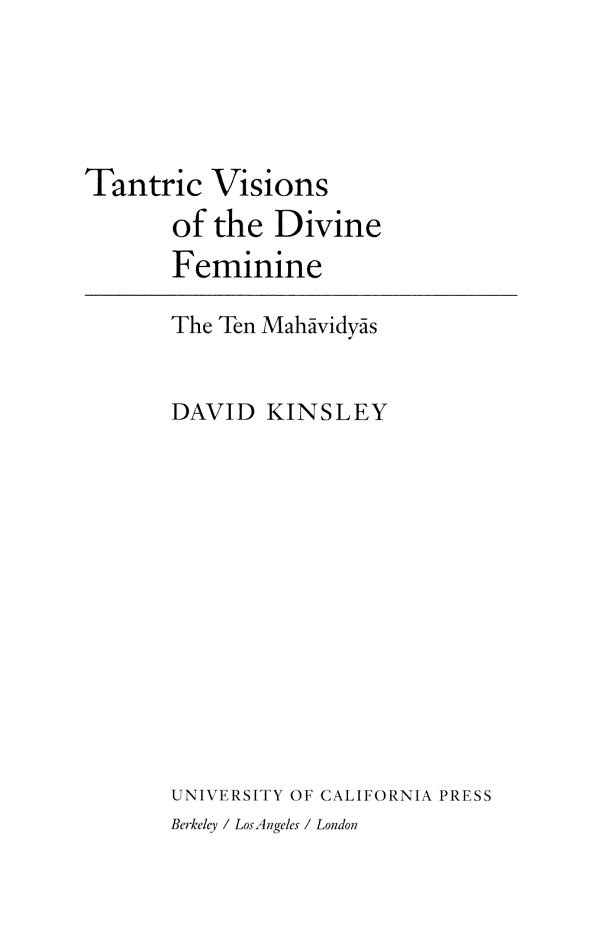
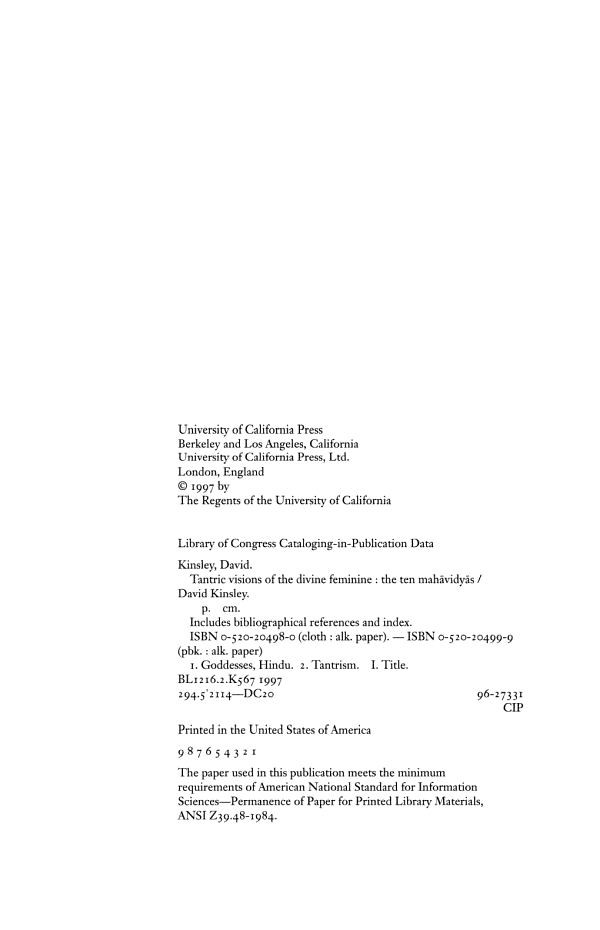
To my friends and teachers
Om Prakash Sharma and Virendra Singh
Acknowledgments
I first became aware of the group of Hindu goddesses known as the ten Mahavidyas while conducting research on the goddess Kali in Calcutta during the academic year 1968-69. Kali is nearly always listed as the first of this group often unusual goddesses and in many ways is the exemplary Mahavidya. It was not until 1983-84 in Varanasi, however, that I began to undertake detailed research on this group. With the help of a fellowship from the Canadian Social Sciences and Humanities Research Council, I investigated literary sources and did field research on Mahavidya temples, iconography, and worship. I returned to Varanasi in 1992-93 to continue my research, this time with the help of a grant from McMaster University Arts Research Board.
During my research in Varanasi I was fortunate to have the assistance of many people. Om Prakash Sharma was indispensable in helping me locate several Mahavidya temples and paintings, putting me in touch with many knowledgeable people, and finding relevant texts. Virendra Singh, who patiently attempted to teach me Hindi, was always encouraging about my work. Mahant Sri Rama Shankar Tripathi of the Kashi Vishvanath temple held frequent useful discussions with me during 1983-84 and translated several relevant Sanskrit texts about the Mahavidyas for me. Hemendra Nath Chakravarty was especially important in helping me think through the meaning of several of the Mahavidyas and in locating and translating for me several crucial passages relating to the Mahavidyas as a group and to individual Mahavidyas. I also appreciated the many discussions I had with Mark Dyczkowski at his home overlooking Assi Ghat. I remember these chats as a pleasant blend of sober scholarly inquiry and amusing speculation on the mysteries presented by this unusual group of Hindu goddesses.
Doug Abrams Arava, my editor, has made several discerning suggestions that have very much improved this book and has been unwavering in his attentive support throughout its preparation. I owe special thanks also to the three readers who reviewed the manuscript: Kathleen Erndl, Miranda Shaw, and an anonymous reviewer. Their comments and criticisms proved very useful in revising the book. Victoria Wilson-Schwartz, the University of California Press copyeditor, was attentive, constructive, and unhesitant in scrutinizing my proseto her, thanks very much. I am also grateful to my wife, Carolyn, for the many hours she spent lending this book consistency and clarity, from an early draft through subsequent stages of production.
Introduction
What is one to make of a group of goddesses that includes a goddess who cuts her own head off, another who prefers to be offered polluted items by devotees who themselves are in a state of pollution, one who sits on a corpse while pulling the tongue of a demon, another who has sex astride a male consort who is lying on a cremation pyre, another whose couch has as its legs four great male gods of the Hindu pantheon, another who prefers to be worshiped in a cremation ground with offerings of semen, and yet another who is a haglike widow?
Are these goddesses, who are known as the ten Mahavidyas, bizarre creations of radical groups within the Hindu tradition, obscure beings whose significance is peripheral to the basic themes of Hindu spirituality? Should we dismiss them as tangential, perhaps even irrelevant, to Hindu religion? After years of studying and musing on them, it seems to me that there is a logic to the group as a whole and that even its most outrageous members, if understood within their proper context, reveal important spiritual truths.
We know the Mahavidyas from a variety of sources. Many goddess temples across North India contain paintings and images of them. Contemporary lithographs portray them both as a group and individually. Dhyana mantras describe them for liturgical and meditative purposes, and they are the subject of several tantric digests.
The Mahavidyas have been known as a group since the early medieval period (after the tenth century Ce.).1 Some of them predated this development and continue to be very well known in their own right, such as the fierce black goddess Kali. She is also usually the primary, or aid, Mahavidya. Kamala, who is the same as the very popular goddess SriLaksmi, is also a member of the group. Tara and Tripura-sundari, lesser known but still far from obscure, are other examples of Hindu goddesses who are popular on their own and as part of the group. On the other hand, Bagalamukhi, Chinnamasta, Dhumavati, and Matarigl are rarely mentioned apart from the Mahavidyas.
The aim of this study is to reflect on the meaning of the Mahavidyas, both as a group and as individual deities. As a group, the Mahavidyas present a curious collection. It is not at all apparent why these particular ten goddesses have become associated with one another. As for the individual goddesses, several are obscure and have received no scholarly attention. In some cases the sources available on individual Mahavidyas are so limited that it is difficult, if not impossible, to reconstruct their histories or gain a clear impression of their worship. In many respects this study is not definitive or conclusive. I seek here to bring a preliminary ordering to the Mahavidya tradition in the hope that it will encourage other scholars to undertake more detailed studies of the group and of its individual members.
Throughout my study of the Mahavidyas, I was told many times by a number of peoplepriests, scholars, painters, and practitionersthat the Mahavidyas are "all one." Sometimes they were responding to a question concerning the significance of the group as a whole and sometimes to one concerning the peculiarities of an individual goddess. I often took this reply to indicate that the person did not have an appropriate answer to the question and that the main point, in any case, was to understand the group as so many manifestations of one (or the) great goddess. Such questions as, "Why does Bagalamukhi like yellow?" "What does the name Bagalamukhi mean, and what is its significance?" "Why does Kali stand on Siva?" "What is the significance of the name Matarigl?" often elicited a look of incomprehension (why would I want to know this anyway?), followed by the comment that all of the Mahavidyas are the same: they are all different expressions of the same goddess, who enjoys taking many forms for her own pleasure and the needs of her devotees. I usually took this as a formulaic reply, the kind that Hindus often make to non-Hindus who stand bewildered before the fantastic array of divinity expressed in the immense Hindu pantheon. After a careful study of the individual Mahavidyas, however, it became apparent to me that in many ways this comment, "They are all one," is important in understanding the significance of the individual manifestations and their worship.
Texts that dwell in detail on the Mahavidyasthe Tantrasdra, Sdkta pramoda, Saktisamgama-tantra, and many othersdiscuss each Mahavidya according to a clear structure. That is, the description and worship of each goddess is outlined in very similar terms, no matter how different she may appear from the others. She is made to conform to an accepted structure that has at least two central components: (1) a ritualistic approach to the deity that is individual and tantric in nature and (2) a philosophical/mythological paradigm of the Mahadevi (great goddess) to which the individual Mahavidya is compared or equated.
Next pageFont size:
Interval:
Bookmark:
Similar books «Tantric Visions of the Divine Feminine»
Look at similar books to Tantric Visions of the Divine Feminine. We have selected literature similar in name and meaning in the hope of providing readers with more options to find new, interesting, not yet read works.
Discussion, reviews of the book Tantric Visions of the Divine Feminine and just readers' own opinions. Leave your comments, write what you think about the work, its meaning or the main characters. Specify what exactly you liked and what you didn't like, and why you think so.



